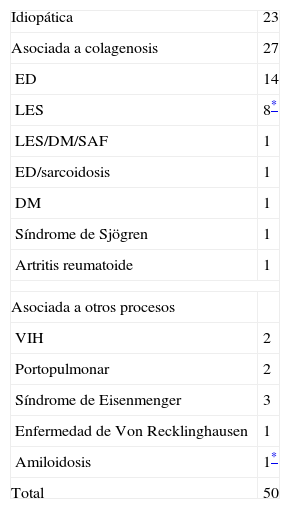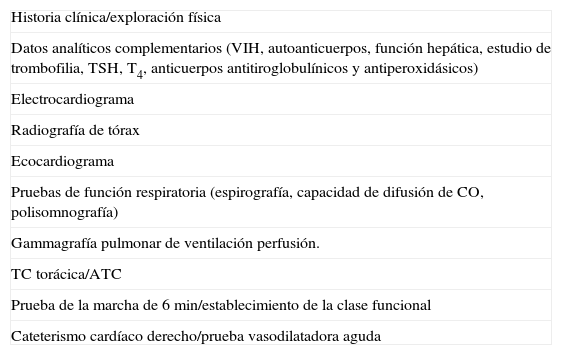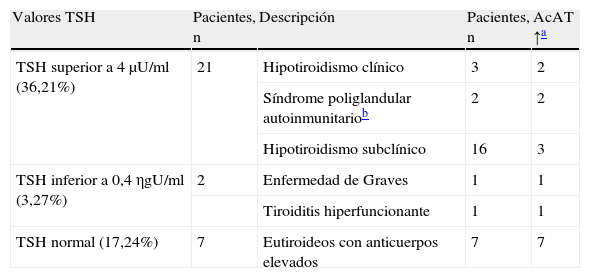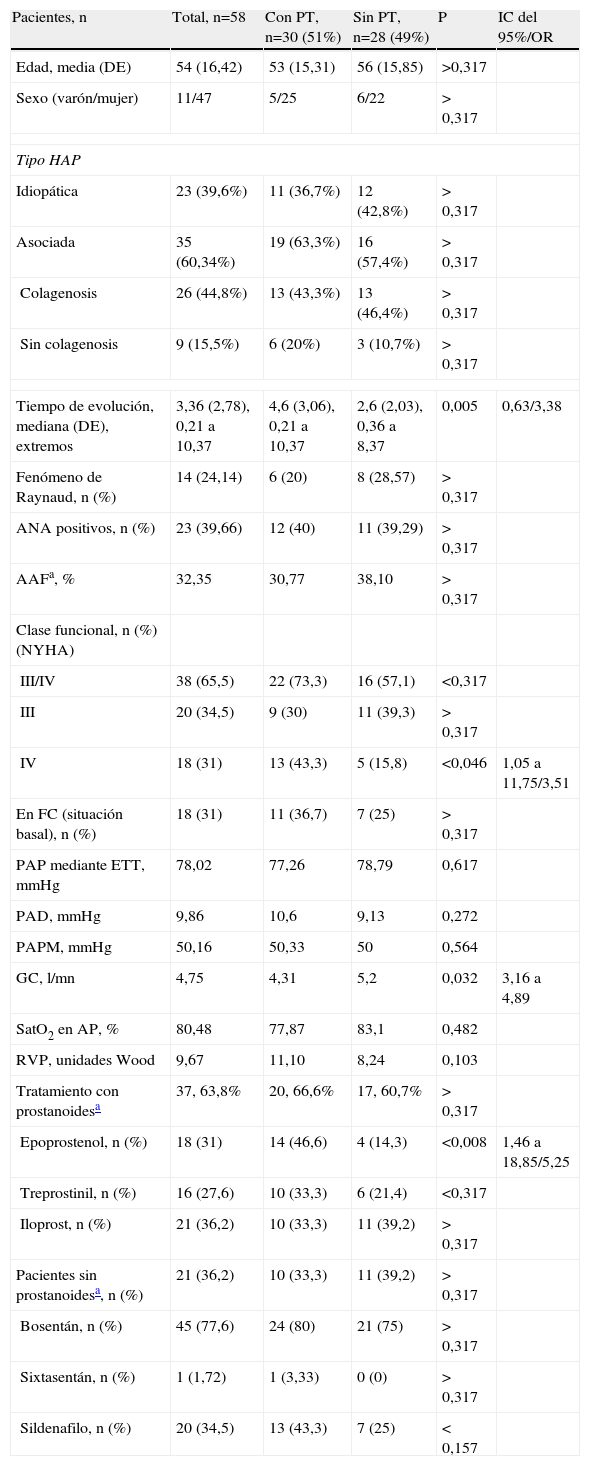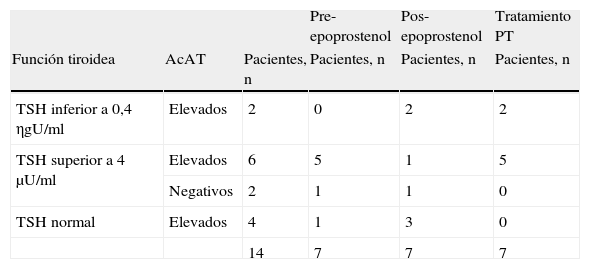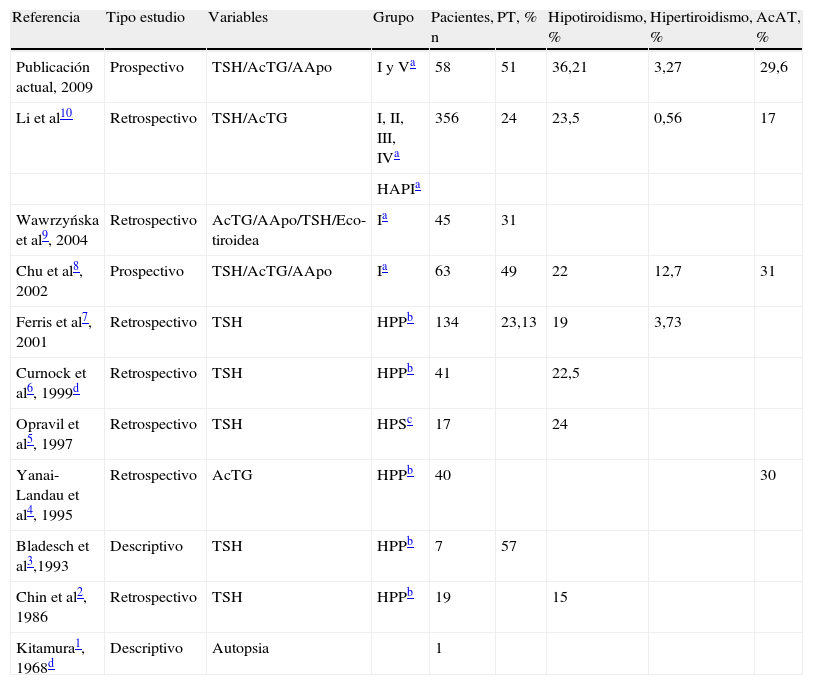La patología tiroidea (PT) es más frecuente en pacientes con hipertensión arterial pulmonar (HAP) que en la población general. No están bien establecidas la frecuencia ni la causa de esta asociación. El objetivo de este trabajo es cuantificar y analizar la incidencia y las características de la PT en una cohorte de pacientes con HAP (idiopática o asociada preferentemente a enfermedades sistémicas) y realizar una revisión de la literatura científica.
Pacientes y métodoSe estudió a 58 pacientes con HAP prospectivamente según un protocolo preestablecido (incluido cateterismo cardíaco derecho) y se determinaron la tirotropina (TSH), la tiroxina libre (T4l) y los anticuerpos antitiroglobulínicos y anticuerpos antiperoxidasa. Se definió la PT como alteración de la TSH o elevación de cualquiera de los 2 anticuerpos antitiroideos (AcAT). Se compararon las variables clínicas, biológicas y hemodinámicas entre los grupos con y sin PT.
ResultadosHabía PT en 30 pacientes (51%): TSH elevada en 21 (36,21%), hipertiroidismo en 2 pacientes (3,45%) y AcAT elevados en 16 de los 54 pacientes (27,59%), 7 de los cuales eran eutiroideos. En el grupo con PT el tiempo de evolución de la HAP fue mayor (4,62 frente a 2,61 años; intervalo de confianza [IC] del 95%: 0,63 a 3,38; p=0,005), hubo más pacientes en clase funcional iv (13 frente a 5, el 43,3 frente al 15,8%; IC del 95%: 0,05 a 11,75; p=0,046), el gasto cardíaco fue menor (IC del 95%: 3,16 a 4,89; p=0,032) y fue más frecuente el tratamiento con epoprostenol (14 frente a 4, el 46 frente al 14,3%; IC del 95%: 1,46 a 18,85; odds ratio de 5,25; p=0,008) que en el grupo sin PT.
ConclusionesLa frecuencia de PT en esta cohorte de pacientes con HAP alcanza un 51% y sólo se relacionó con mayor tiempo de evolución de la enfermedad y con peor situación hemodinámica. Aunque el epoprostenol se utilizó más en el grupo con PT, no puede establecerse una relación causal con la PT.
Thyroid disease (TD) is more prevalent in patients with pulmonary arterial hypertension (PAH) than in the general population. The frequency and the cause of this association are not well established. We aimed to quantify and analyze the incidence and characteristics of TD in a cohort of PAH patients (idiopathic or preferentially associated with systemic diseases) and review the literature.
Patients and methodFifty eight PAH patients were prospectively studied, according to a previously established protocol (that included right heart catheterization); TSH, T4, and antithyroglobulin and antiperoxidase antibodies were determined. TD was defined as an abnormal TSH level and/or elevated antithyroid antibodies (TAbs). Clinical, biological and hemodynamic variables were compared between patients with and without TD.
ResultsTD was detected in 30 patients (51%): high TSH levels were observed in 21 (36,21%); hyperthyroidism in 2 (3,45%); and TAbs in 16 of 54 (27,59%), 7 of whom were euthyroid. In the TD group, PAH evolution time was longer (4,62 vs 2,61 years; P=.005, CI 95%, 0,63–3,38), more patients were in functional class IV (13;43,3% vs 5;15,8%, P=.046, CI 95% ,0,05–11,75), cardiac output was lower (P=.032, CI 95%, 3,16–4,89) and epoprostenol treatment was more frequently used (14;46,6% vs 4;14,3%, P=.008, CI 95%, 1,46–18,85; OR=5,25).
ConclusionsThe frequency of TD detected in this PAH cohort reaches 51% and it was associated with a longer evolution time of PAH and worse hemodynamic situation. Although epoprostenol was used more frequently in TD patients, a causal relationship with TD could not be established.
Artículo
Comprando el artículo el PDF del mismo podrá ser descargado
Precio 19,34 €
Comprar ahora






